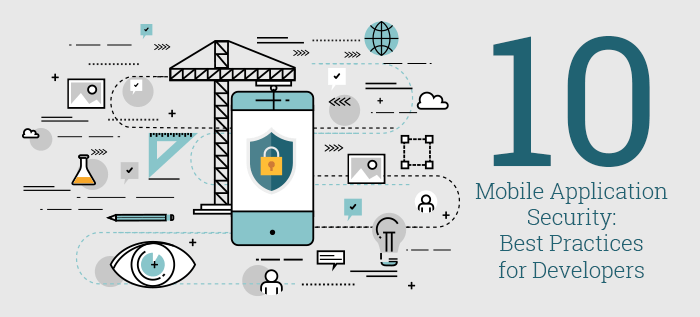A Comprehensive Guide for Developers for Impenetrable Mobile App Security
Remember the movie ‘Time of the Apes?’ Well, you don’t need to because this is the ‘Time of the Apps!’ Okay, this was a terrible pun (is it even a pun?), but don’t judge us based on just one pun as we’ve got much more to offer – but not in this blog because we’ve got a stringent policy of ‘one pun per blog.’ Yes, that’s a real thing! We know it’s sad, but we can’t do anything about it, our hands are tied ☹. That’s why we’re going to try putting on a serious face like Mike Ehrmantraut of Breaking Bad and focus on Mobile Application Security best practices for Developers.
Let us make it clear that this is an article for app developers, but you can still stick around if you aren’t one – if you’re curious enough. Developer, we know how harsh the world can be for you people. Those thousands of lines of code (a good part of which is never used), crazy demands of your clients, the endless cycle of bugs and fixes, those deadly deadlines, and to top it all, you must make it secure! We won’t spend much time in sympathizing as you’re the one who chose to be a developer. But what we will do is we will give you an all-inclusive mobile app security best practices guide that will get some ounces off your shoulders. No matter what type of app you want to develop, this guide should help you anywhere, anytime.

Without wasting much time, let’s go straight to the points. Let’s have a look at Android app ideas from the security point of view.
Mobile App Security Best Practices for Developers
1) Start from the start
As much as we hate to use clichés, we can’t help but come up with this line: ‘Mobile app security is not a sprint, it’s a marathon.’ When you think and implement security from the very start of your development, you leave very little room for costly, time-consuming fixes. Keep a security checklist side-by-side and if possible, assign the security duties to an individual who’d supervise it. Here’s an excellent checklist for your app security.
2) Penetration testing
Increasingly, testing methods such as SAST (Static Application Security Testing) is becoming mandatory for IT organizations and rightly so. SAST tests penetrate your source code and decipher security micro security loopholes. There are many tools through which you can do penetration testing of your app.
3) Code signing certificate
We don’t need to tell you because you already know it. But just for the sake of this article, we want to tell you that you need to sign and encrypt your code using a Code Signing certificate. Once done, your code gets encrypted, and any malicious party cannot fool your users by spoofing your app. By publishing the developer’s name, the end-users can know that the app is genuine and that it hasn’t been tampered with. If you’re unsure of using a Code Signing certificate and want to know whether it’s worth the investment, you should head straight to this blog post.
Buy Comodo Code Signing at $69 Per Year – 59% Off
4) Be careful while using third-party libraries
We know how much you want to use third-party libraries, but before you do that, you should test your code extensively. There have been many incidents in recent times that caused some severe mayhems due to insecure third-party libraries. So, be careful!
5) Secure and agile code
Now you might say that this is another cliché point. But try to understand it a bit from our perspective. How awful an article on app security would look if it doesn’t tell you to secure your code. Making your app secure should be your number one priority all along the development.
6) Secure client to server communication
Not only the stored data, but the data-in-transit also needs to be secured to avoid man-in-the-middle (MiTM) attacks. To secure server communication, you’ve got two options. You can either go with SSL or a VPN tunnel. However, keeping everything in mind, we’d recommend you go with SSL/TLS.
7) Encrypt the data
We cannot stress enough on this point. You should encrypt every bit of data that is transmitted to user’s phone. This way, even if a hacker manages to get his/her hands on the data, he/she won’t be able to (mis)use it. And of course, use unbroken protocols such as 256-bit AES encryption.
Here’s a comprehensive guide for HTTPS on Android and iOS devices.
Buy Comodo SSL Certificate at $5.88 Per Year – 89% Off
8) Sturdy authentication, session management, and authorization
When it comes to mobile app security, authentication and authorization are two of the most crucial factors. Developers must make sure that the end-user passwords are highly secure, and they must also enable multi-factor authentication. If the app deals with highly-sensitive information, the user must be made to log in for every new session. Every developer should implement OAuth 2.0 authorization framework or the OpenID Connect protocol by using their current versions.
9) The less your app knows, the better
The principle of least privilege states that an app should ask for the data that it absolutely needs. Don’t make your app request for access to messages if you don’t need them. Keep your accesses at the bare minimum.
10) Constant App testing and regular updates
No platform is 100% secure. Even if you scrutinize at every stage, there will be some dark spots left behind. That’s why app testing should never stop. If you can afford, you can also start your own bug bounty program.
As you keep finding the flaws, keep on releasing timely updates so that your users don’t suffer.


![A 6-Minute Overview of the PCI DSS Requirements [For PCI DSS v.4.0]](https://cheapsslsecurity.com/blog/wp-content/uploads/2022/12/pci-dss-requirements-v4-370x245.jpg)

